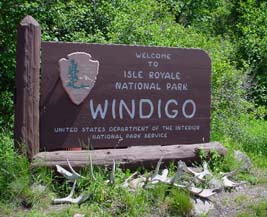Hiking Isle Royale National Park
Click on any photo to see a larger image
Iíve wanted to hike Isle Royale for 35 years but something else always seemed to take priority Ė school, work, family, work, house, work, cruising, work. Now that Iím retired and have a bit more free time, Iíve been chipping away at my ďalways wanted to do but never got around toĒ list. So when Jon, a long-time friend and scoutmaster, mentioned he was taking some of his Boy Scouts (Troop 620, Clare, Michigan) to hike the length of Isle Royale and was short one adult leader, I quickly volunteered.
My daughter jokingly wondered aloud whether I could handle it. Not the hiking. The kids. I usually hike, sail, and canoe solo. Bad weather, bugs, trail food, and physical rigors are one thing. Fourteen 12 to 15 year-old boys are quite another.
The group going on the trip ended up totaling 23 people -- 14 scouts, six adult leaders, and a ďsupport teamĒ consisting of Jonís wife and daughter and another leaderís wife. We left Clare at 8:15 a.m. on June 18, 2005 in three vehicles, two of them towing trailers. Two mornings later we boarded the ferry at Grand Portage, Minnesota and began the final 22 mile leg of our journey across Lake Superior to Isle Royale.
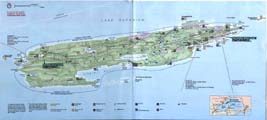 Isle Royale National Park is an isolated archipelago of islands located in the northwest corner of Lake Superior that is accessible only by boat or seaplane. More people visit Yellowstone National Park in one day than visit Isle Royale in a year. Ninety-nine percent of the parkís land mass is federally designated wilderness and stringent regulations are in place to protect the fragile ecosystem. Among other things, campers and boaters heading into the backcountry are required to obtain a permit and attend an orientation session immediately upon their arrival. There are no roads on the island and all wheeled vehicles and devices and mechanical forms of transportation (except wheelchairs) are prohibited. To protect wildlife from diseases to which they have no immunity, no dogs, cats, or other pets are allowed. (In the late 1980s and early 1990s disease decimated the Isle Royale wolf population. Canine parvovirus introduced by a domesticated dog is suspected.)
Isle Royale National Park is an isolated archipelago of islands located in the northwest corner of Lake Superior that is accessible only by boat or seaplane. More people visit Yellowstone National Park in one day than visit Isle Royale in a year. Ninety-nine percent of the parkís land mass is federally designated wilderness and stringent regulations are in place to protect the fragile ecosystem. Among other things, campers and boaters heading into the backcountry are required to obtain a permit and attend an orientation session immediately upon their arrival. There are no roads on the island and all wheeled vehicles and devices and mechanical forms of transportation (except wheelchairs) are prohibited. To protect wildlife from diseases to which they have no immunity, no dogs, cats, or other pets are allowed. (In the late 1980s and early 1990s disease decimated the Isle Royale wolf population. Canine parvovirus introduced by a domesticated dog is suspected.)
Isle Royale itself is 45 miles long and up to 9 miles wide. The only way to tour the island is by foot or watercraft. One hundred sixty-five miles of hiking trails crisscross the island and 36 campgrounds (some with docks) are available for use by backpackers and recreational boaters. The only transient accommodations are at Rock Harbor Lodge (where off-season rates for double occupancy begin at $165 per night). Visitors must pay a user fee of $4 per person per day or purchase a season pass for $50. There are two ports of entry -- Windigo on the west end of the island and Rock Harbor on the east end. Both have a visitor center, marina, small store with limited (and expensive) supplies, and token operated showers. Rock Harbor also has a restaurant and snack bar.
Currently, about 500 moose and 30 wolves roam the island. There are no deer or bear. Isle Royale supports the only known loon population that uses Great Lakes waters for nesting. The only ticks are moose ticks and they do not consider humans a food source. (That is fortunate for us but not for the moose. Moose covered with tens of thousands of ticks, two or three per square inch of body surface, have been reported.) Black flies can be a problem in the spring but were gone by the time we got there. Mosquitoes, however, had filled the void and were out in force. A separate sub-species of red squirrel has evolved on the island. These squirrels and ravens occupy the niche of ďcamp raiders.Ē Turn away from any food left out and there is more than a chance it will be gone when you turn back around, even if it is broad daylight. While camped at Lake Desor, a scout who was carrying some of our food left the top of his pack open when he went swimming. As Jon and I walked over to close his pack, a squirrel clambered out from inside and scampered away.
For more information about Isle Royale National Park, two good places to start are http://www.nps.gov/isro/home.htm and http://www.isle.royale.national-park.com/info.htm.
Because park regulations limit groups to a maximum of 10 people, Jon divided the scouts and leaders into two groups of seven boys and three adults each. One group started at Windigo on the west end of the island and hiked east; the other group (the one Jon and I were in) began at Rock Harbor and traveled west. Our three woman support team stayed at Rock Harbor Lodge and day hiked, then took the ferry back to Grand Portage while we were on the trail.
Day 1 -- Monday, June 20, 2005
 It takes two to three hours for the ferry to make the crossing from Grand Portage to Windigo. We got off there briefly to get our permit and orientation. Then it was back on the boat and another five hour ride along the north shore of Isle Royale to Rock Harbor. The weather was close to ideal -- a light blue sky draped with veils of white gauze, bumpy seas that flattened out in the sheltered lee of the island, the radiant warmth of the sun struggling to ward off the combined chill of the cool air and 38 degree Lake Superior water.
It takes two to three hours for the ferry to make the crossing from Grand Portage to Windigo. We got off there briefly to get our permit and orientation. Then it was back on the boat and another five hour ride along the north shore of Isle Royale to Rock Harbor. The weather was close to ideal -- a light blue sky draped with veils of white gauze, bumpy seas that flattened out in the sheltered lee of the island, the radiant warmth of the sun struggling to ward off the combined chill of the cool air and 38 degree Lake Superior water.
We arrived at Rock Harbor around 3:00 p.m. and set up camp. Hordes of mosquitoes extended their hospitality and welcomed us as blood brothers. Because we were a group, the screened Adirondack shelters were off limits. The only escape was the developed harbor area, so thatís where we spent the rest of the afternoon and evening -- sightseeing, eating dinner at our support teamís (i.e., the womenís) housekeeping cabin, and attending a presentation about the moose-wolf predation relationship.
Four hikers who had walked from Windigo told us they used up three cans of insect repellent. That got us questioning whether we had enough with us. To be safe, Jon is going to buy another can at the store before leaving tomorrow morning.
Day 2 -- Tuesday, June 21, 2005 (Rock Harbor to Daisy Farm, 7.2 miles)
Up at 6:00 a.m. Iím a night person and my biological clock is complaining. To make matters worse, I didnít have my morning Coke either. (Iím referring to Coca-Cola.) Windigo, six days away, is the next place Iíll be able to get a Coke. But there is no way Iím going to start drinking coffee. (How can coffee smell so good and taste so yucky?) And forget about caffeine pills. The whole point of a vice is to savor the sensual pleasures it offers. Iíd rather go without than gulp down some dried, compressed, tasteless, quick and easy substitute. (Trail food doesnít count because itís a necessity.)
The absolutely, positively, first thing that needs to be done in the morning is cover all exposed skin with insect repellent. From now on, Iím going to avoid middle-of-the-night potty runs if at all possible. Two years ago that would have been wishful thinking. (Male senior citizens know what I mean.) I would never pay a dime, much less thousands of dollars, for cosmetic surgery to restore the appearance of youth. But my prostate surgery was worth every penny -- it restored a function of youth.
Our support team made us a breakfast of pancakes and sausage and prepared sack lunches. Weíre gloating. The other group only has trail food to eat today. It pays to be in the scoutmasterís group.
After breaking camp, we filled our water bottles at the campsite spigot. Potable water is only available at Rock Harbor and Windigo. From now on all our drinking water will have to be filtered or boiled. The hydatid tapeworm, which can be present in lake and stream water on the island, cannot be killed by chemical treatments such as iodine. Weíre carrying two water filters -- Jonís SweetWater and my Mini-Works.
Another gorgeous day. Only 7.2 miles to Daisy Farm campground, todayís destination, but our packs are loaded with six days worth of supplies. We put most of the consumables in the boysí packs so their loads will lighten a little every day. Jon, Ray (the third adult), and I divided the remaining supplies and the bulk of the group gear among us. Weíre each carrying 45-50 pounds and thatís not going to change much.
 The trail parallels the islandís south shoreline and is extremely scenic. Itís also extremely rocky and covered with exposed tree roots, which makes for rough and slow going. At about the half-way point we met a backpacker headed in the opposite direction hiking in sandals. I donít know how he managed. My toes would have been bloody stumps if I had tried that. But Iím podiatrically challenged.
The trail parallels the islandís south shoreline and is extremely scenic. Itís also extremely rocky and covered with exposed tree roots, which makes for rough and slow going. At about the half-way point we met a backpacker headed in the opposite direction hiking in sandals. I donít know how he managed. My toes would have been bloody stumps if I had tried that. But Iím podiatrically challenged.
We arrived at Daisy Farm at mid-afternoon. The campsites are inland but the trail to them passes a beach and dock. The temperature had risen to the low 80s and the cold Lake Superior water beckoned so we took a short break to cool off. After setting up camp, we returned to the lakeshore to relax, filter water, and escape the mosquitoes.
Using two small filters to pump enough water for 10 people is very time consuming. We had to replenish all the water drunk during the dayís hike plus filter the amount needed for cooking dinner, dishwashing, hygiene, and topping off our water bottles the next morning. In addition, we supplied water to two hikers who came to the island with only iodine tablets, not realizing that was insufficient protection against tapeworm. But we had plenty of time and it kept the boys busy.
The romantic in me kept expecting our support team to show up. Hereís why: Jon had last hiked Isle Royale 27 years ago. Then, as now, he had started at Rock Harbor. When he went to the store to purchase a few items, he met and spent some time talking to the young, attractive female sales clerk on duty. The following day Jon hiked to Daisy Farm. He noticed the woman from the store was there. It was her day off and she had used one of the concessionís rental boats to take a day trip to the campground. Jon struck up a conversation and learned, among other things, her name was Liz, that working in the Rock Harbor store was just a temporary summer job, and her permanent place of residence and employment was a small Michigan town located just 30 miles south of the town he lived and worked in. That fall, Jon tracked down Lizís telephone number and called her. They got married a year later.
I was beginning to lose hope when Liz (and the other two women) pulled up to the dock in a small outboard powered rental boat. It was the perfect ending to the day.
Tonight we learned it is best to eat dinner early in order to avoid the crowds of mosquitoes dining later. Finishing up some chores before turning in, I was mindlessly swatting at the mosquitoes landing on and trying to bite me through my clothes. It did not dawn on me until it was too late that it was not a good idea to whack the mosquito that had alighted on the fly of my pants.
Day 3 -- Wednesday, June 22, 2005 (Daisy Farm to West Chickenbone Lake, 8.1 miles)
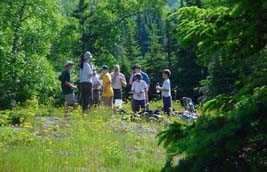 The trail from Daisy Farm up to Greenstone Ridge was mostly tree-lined but ran through frequent clearings formed by outcrops of rock. The rapid increase in elevation made us work. Like yesterday, the boys led and the adults brought up the rear. Most of the time I was straggling some distance behind. The boys speed walk for about 20 minutes then stop for a long break. I just amble along at 2-2 Ĺ mph. Weíve tried to get the boys to pace themselves better and slow down and smell the roses but without much success so far.
The trail from Daisy Farm up to Greenstone Ridge was mostly tree-lined but ran through frequent clearings formed by outcrops of rock. The rapid increase in elevation made us work. Like yesterday, the boys led and the adults brought up the rear. Most of the time I was straggling some distance behind. The boys speed walk for about 20 minutes then stop for a long break. I just amble along at 2-2 Ĺ mph. Weíve tried to get the boys to pace themselves better and slow down and smell the roses but without much success so far.
It cooled down to the high 50s last night but itís going to be another 80 degree day. The clearings provide nice places for breaks. They are open to the slight breeze and tend to be bug free zones.
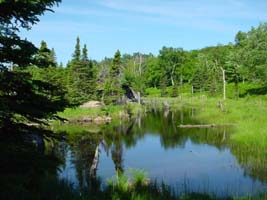
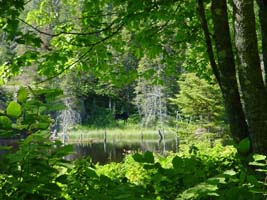 The trail skirted a picturesque bog. I stopped to take a photo while everyone else went on ahead. I resumed hiking and had gone maybe 200 yards when I caught up to the group huddled together on the trail peering through an opening in the trees at a magnificent bull moose standing on the far shore of the bog. I zoomed in as much as my digital camera would allow but one still has to look closely to pick him out in the center of the photo.
The trail skirted a picturesque bog. I stopped to take a photo while everyone else went on ahead. I resumed hiking and had gone maybe 200 yards when I caught up to the group huddled together on the trail peering through an opening in the trees at a magnificent bull moose standing on the far shore of the bog. I zoomed in as much as my digital camera would allow but one still has to look closely to pick him out in the center of the photo.

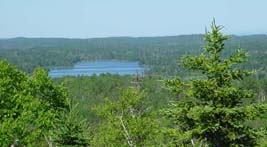 It was late morning when we topped Greenstone Ridge. At the trail junction we were treated to spectacular views of the north shore of Isle Royale with Canada in the distance and Sargent Lake to the west.
It was late morning when we topped Greenstone Ridge. At the trail junction we were treated to spectacular views of the north shore of Isle Royale with Canada in the distance and Sargent Lake to the west.
 On top of the ridge, the trail leveled out and opened up. Angleworm Lake was visible below and to our left as we proceeded west. But the trees remained dense enough to block any view of Lake Superior.
On top of the ridge, the trail leveled out and opened up. Angleworm Lake was visible below and to our left as we proceeded west. But the trees remained dense enough to block any view of Lake Superior.
As we approached West Chickenbone Lake campground the woods thickened and we began encountering steep ups and downs. We were disappointed to discover the group campsites were located far away and uphill from and with no view of the lake. The individual sites were closer and more scenic, including some right on shore overlooking the lake.
Upon arrival, Jon and I walked down to the lake to scope out the best place to get water. We rejected a spot at the end of a short side trail. Farther along the main trail we found what appeared to be the community watering hole. We returned to the campsite, sent a few of the boys down to begin pumping water, and put the rest to work setting up camp. After that was done, I headed down to the lake to supervise the water collection. I met the boys walking back on the trail towards me. ďWhere are you going?Ē I asked.
ďThe people at the place you sent us to said there was a cut-off that led to a better spot to get water.Ē
I tagged along and we ended up at the spot Jon and I had earlier rejected. I left the boys there and walked to the watering hole. Five adults were there, including a volunteer trail maintainer. One was standing in the lake fishing. Two were filtering water. I returned and got the boys, accompanied them to the watering hole, began filtering water, and had them do the same with our second filter. I was upset with the other hikers for sending the boys to what they had to know was a worse source of water, but I didnít say anything and silently dared them to protest our presence. They didnít.
During the time we were collecting water, three painted turtles with shells about eight inches across emerged from the lake and, ever so slowly, worked their way inland through the underbrush. I was told they were females in search of suitable soil to lay eggs.
Ray has become our head chef. He can do the most amazing things with boiling water. But he made us promise not to tell his wife. Ooops.
Day 4 -- Thursday, June 23, 2005 (West Chickenbone Lake to Hatchet Lake, 8.1 miles)
At 2:45 a.m. Jon and I were awakened by the rumble of thunder and flashes of lightning of an approaching storm. We got up, moved all the backpacks under the tarp we had rigged for shade the previous afternoon, and made sure the tents were closed up and secure. Have I mentioned how bad the mosquitoes were? In the short time it took us to prepare for the storm, I was covered with bites. Granted, I was an easy target in shorts and sandals. But Iím willing to bet that even if I had been wearing my rain jacket and pants and standing under a waterfall they would have found some way to get me.
It poured rain until around 6:30 a.m. and then began to taper off. We slept in and by 8 oíclock. the rain had all but ended. We ate a quick breakfast, packed the wet tents, and were on the trail by 9:30.
The consensus was that, because I was the slowest hiker, I should lead. The boys were tired after two days of fairly rigorous stop-and-go hiking and had become open to the idea that a slow and steady pace might be preferable. It wasnít long before they were commenting that my pace was ideal. I started by going 30 minutes between breaks and slowly increased that time until, on the last day of the hike, they were easily managing 45 minutes to an hour without stopping.
The trail just west of Chickenbone Lake was so overgrown it was barely visible beneath the overhanging leaves of knee to thigh high vegetation that was dripping wet from this morningís rain. Budget cuts have resulted in trail maintenance being cut in half and it showed. It wasnít long before our pant legs were soaked and covered with mud. The high humidity and already warm air temperatures added to the discomfort.
Today we will reach Mount Siskiwit, the half-way point of our hike. If the other group is on schedule, we will rendezvous and have lunch with them there.
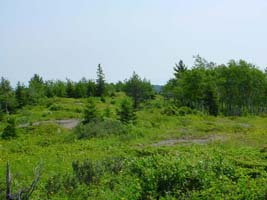
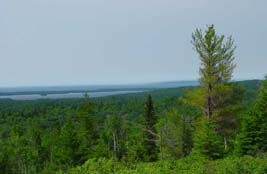 After about an hour-and-a-half, we broke out of the woods onto an exposed section of the ridge. A 25 mph wind made the 80 degree temperature feel pleasantly cool and quickly dried our clothing. The view of Lake Siskiwit in the foreground and Lake Superior in the background was breathtaking.
After about an hour-and-a-half, we broke out of the woods onto an exposed section of the ridge. A 25 mph wind made the 80 degree temperature feel pleasantly cool and quickly dried our clothing. The view of Lake Siskiwit in the foreground and Lake Superior in the background was breathtaking.
Jon opined we had reached Mount Siskiwit. But after consulting the topographical map and taking bearings, we concluded it was farther down the trail. We repeated this exercise twice more. The fourth time, however, we were confident we had summited Mount Siskiwit (elevation 1205 feet) and stopped to have lunch and wait for the other group to arrive.
 While lunch was being prepared, Jonís son Sam went exploring and discovered the remnants of a moose skeleton in a nearby copse of trees.
While lunch was being prepared, Jonís son Sam went exploring and discovered the remnants of a moose skeleton in a nearby copse of trees.
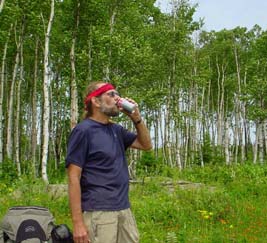 After lunch, Jon removed a clear plastic cylinder from his pack. It contained a smaller diameter gray cylinder surrounded by red licorice. He passed out the licorice as a treat then handed the gray cylinder to me. The gray was duct tape. I peeled it away from the top of the cylinder, exposing the red and white logo of a 12 ounce can of Coca-Cola Classic. Jon had been carrying the can in his pack for two-and-a-half days just so he could surprise me with it on Mount Siskiwit. I was completely surprised and very grateful. But I wasnít about to carry the weight, so I drank the entire can of Coke then and there Ė- slowly, so I could savor it.
After lunch, Jon removed a clear plastic cylinder from his pack. It contained a smaller diameter gray cylinder surrounded by red licorice. He passed out the licorice as a treat then handed the gray cylinder to me. The gray was duct tape. I peeled it away from the top of the cylinder, exposing the red and white logo of a 12 ounce can of Coca-Cola Classic. Jon had been carrying the can in his pack for two-and-a-half days just so he could surprise me with it on Mount Siskiwit. I was completely surprised and very grateful. But I wasnít about to carry the weight, so I drank the entire can of Coke then and there Ė- slowly, so I could savor it.
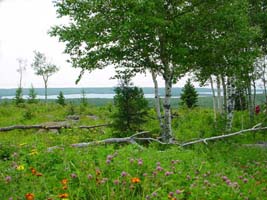 When, after an hour, the other group had not appeared, we prepared to push on. But before we could get going, the lead hiker of the other group showed up. The rest of the hikers trickled in over the next few minutes. The exuberance with which the two groups of scouts greeted each other and carried on would have caused a stranger to think they had been separated for four years instead of just four days. It turned out the other group had been waiting for us on their Mount Siskiwit for 40 minutes. To avoid confusion in the future, the Park Service needs to erect a sign marking the place we stopped as the location of the real Mount Siskiwit.
When, after an hour, the other group had not appeared, we prepared to push on. But before we could get going, the lead hiker of the other group showed up. The rest of the hikers trickled in over the next few minutes. The exuberance with which the two groups of scouts greeted each other and carried on would have caused a stranger to think they had been separated for four years instead of just four days. It turned out the other group had been waiting for us on their Mount Siskiwit for 40 minutes. To avoid confusion in the future, the Park Service needs to erect a sign marking the place we stopped as the location of the real Mount Siskiwit.
The trail became a series of steep ascents and descents generally rising in elevation. We left the exposed ridge behind and entered woods that were thick with undergrowth and mosquitoes. From this point on, the character of the trail changed noticeably. The rock clearings all but disappeared. The only view was of the surrounding forest. The trail was a sinuous brown groove worn into a green carpet.
The other group had warned us the trail down to Hatchet Lake was steep and difficult. But the campsite was worth it, the best so far. Open and spacious. A large area for cooking and congregating with a half-dozen large diameter birch logs for seats. Level and well groomed tent pads. Lake access nearby.
Other than the ubiquitous mosquitoes, the only downside was the impending failure of Jonís water filter. It was taking significantly more time and effort to produce less water. Cleaning the element did little good. My Mini-Works became our primary filter and itís not intended to supply water for 10 people.
Day 5 -- Friday, June 24, 2005 (Hatchet Lake to Lake Desor, 8.3 miles)
Last night never cooled off. The low temperature was 74 degrees. Today is going to be a scorcher.
No one looked forward to the climb up from Hatchet Lake to the trail junction, but we made it with only one rest stop. The trail and terrain to the west was much the same as yesterday afternoon. But the temperature was warmer and the insects were twice as bad, no longer merely a nuisance but now an annoyance. There were hardly any decent places to take breaks so we tried to stop as infrequently and briefly as possible.
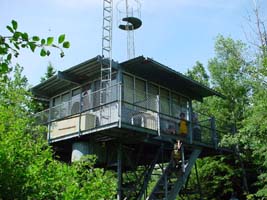 It was a relief to reach the abandoned watchtower at Ishpeming Point. The open area beneath the raised structure allowed in some breeze and was comparatively free of bugs. There undoubtedly was a good view when the watchtower was built. But the surrounding trees have since grown so tall that even from the watchtower platform all that could be seen were treetops.
It was a relief to reach the abandoned watchtower at Ishpeming Point. The open area beneath the raised structure allowed in some breeze and was comparatively free of bugs. There undoubtedly was a good view when the watchtower was built. But the surrounding trees have since grown so tall that even from the watchtower platform all that could be seen were treetops.
After a lengthy break, we continued on to Lake Desor at a fairly fast (for us) pace. Perhaps it was because we were trying to outrun the bugs. Or because we were finally getting into shape. Or because the boysí packs were considerably lighter than when they started. Or because we were drawn by the lure of a refreshing swim. We had been cautioned that Hatchet and Chickenbone lakes contained leeches. That had been enough to discourage us from swimming even though the weather was hot. Lake Desor, however, was reportedly leech free and the campsite we were heading for was located near a nice beach.
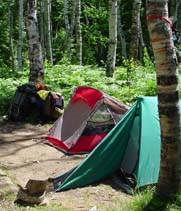
 We covered 8.3 miles in five hours, arriving at South Lake Desor campground at 1:00 p.m.. The campsite was as nice as the one at Hatchet Lake, but better overall because of the swimming beach and a strong onshore breeze that was keeping the insects at bay. We had the time and a great place to chill out, so we did.
We covered 8.3 miles in five hours, arriving at South Lake Desor campground at 1:00 p.m.. The campsite was as nice as the one at Hatchet Lake, but better overall because of the swimming beach and a strong onshore breeze that was keeping the insects at bay. We had the time and a great place to chill out, so we did.
Jonís water filter is dead. It took a long time using my filter just to fill our water bottles. We had plenty of stove fuel so we boiled all the other water we needed.
Our original itinerary called for short hikes the next two days -- 5.8 and 6.8 miles respectively. But with the end in sight and the comforts of civilization so near, the possibility of hiking straight through to Windigo (about 12 miles) was raised. One of the scouts pointed out that if we could arrive at Windigo before 3:00 p.m., the departure time for the ferry to Grand Portage, we could get off the island a day early. After some quick mental calculations I told the group I thought it was doable if we were on the trail by 7 a.m. the next morning. The boys were game to try and everyone went to bed early.
Day 6 -- Saturday, June 26, 2005 (Lake Desor to Windigo, 11.8 miles)
We were on the trail at 6:50 a.m. The trail was easy, allowing us to maintain a good 2 Ĺ mph pace and go at least 45 minutes between short breaks. We made much better time than I had anticipated and arrived at Windigo at 12:45 p.m., having covered just under 12 miles in slightly less than six hours.
I was impressed. Not just with the boysí ability to hike a 12 mile day, but by what they had accomplished. They had traversed the length of Isle Royale on foot carrying full packs, 43.5 miles of true wilderness hiking in five days. Not unexpectedly, they acted their age at times. But not once did they complain or whine. Not once did they argue with each other. Not once did their spirits flag. Except for a skinned knee and a few blisters, they suffered no injuries. At just 12 to 15 years of age, they did something relatively few adults have done.
I also admire Jon for all that he did to make that experience possible. The trip was expensive and required an incredible amount of planning, preparation, organization, and logistical coordination. The fact that it came off so smoothly is a testament to his dedication and ability.
Jon arranged passage for us on the ferry. We ate lunch and I bought everyone soft drinks (mostly Cokes, of course) to celebrate the successful completion of our hike. Then we played tourist until the ferry was ready to depart.
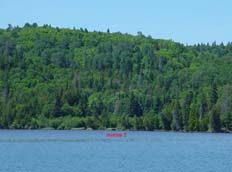
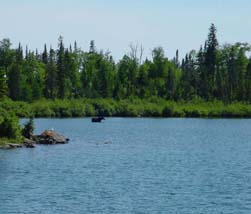 While I was relaxing in a shaded spot near the harbor, a hiker asked me if I had seen any moose. ďOnly oneĒ I answered. He asked if I wanted to see another and directed my attention to one that was feeding on the opposite side of the bay from the harbor. It was barely visible against the backdrop of the shoreline, but I saw it. That was moose number 2.
While I was relaxing in a shaded spot near the harbor, a hiker asked me if I had seen any moose. ďOnly oneĒ I answered. He asked if I wanted to see another and directed my attention to one that was feeding on the opposite side of the bay from the harbor. It was barely visible against the backdrop of the shoreline, but I saw it. That was moose number 2.
Shortly after the ferry got underway, it entered a small bay for a mail pickup. Sam came hurriedly to the stern where I was sitting and yelled ďGuenther, bring your camera!Ē I followed him and there, off the starboard bow, was another moose standing in the shallows.
Two moose sightings on the last day. Now thatís the way to end a hike.
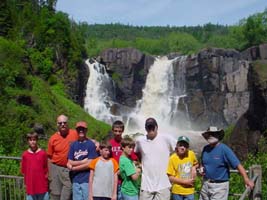 |
| Our group the day after the hike at Pigeon River falls |
| From left to right: Joe, Ray, Kyle, Jesse, Sam, Mike, Curtis, Garrett, Jon |
David Guenther
